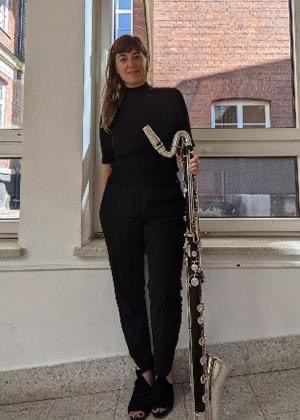Gina Bachauer International Piano Foundation: Kuok-Wai Lio
The 2022-23 concert series of the Gina Bachauer International Piano Foundation opened with a masterly display of holistic musical emotion in Kuok-Wai Lio’s presentation of Schubert’s final three piano sonatas. A 2005 Bachauer gold medalist, Kuok-Wai delivered a memorable valedictory performance of these works, showing his profound admiration for this extraordinary trio of sonatas.
He was ideally precise and delicate in the right moments and spontaneously virtuosic whenever the music required it. His performance also revealed a great deal about his expressive personality. There was a soothing mellowness shrouding the music for the evening, which actually flew by quickly.
The first sonata of the set, the C Minor (D. 958), is the strongest example of Schubert’s nod to Beethoven but the Allegro finale also reminded the listener of Schubert’s famous rendering of Goethe’s Erlkönig. The middle sonata, the A Major (D. 959), was effused with pastoral, playful and nostalgic moments, such as those found in Beethoven’s Sixth Symphony. In the Andantino movement, he switched the mood to an ethereal eeriness. This particular sonata’s performance highlighted Kuok-Wai’s desire to exude the gentle, clear premises of these works. The Andantino movement sounded particularly novel and fresh, as Kuok-Wai leads the listener to share his own revelations he discovered when he decided to prepare these sonatas to include in his concert repertoire.
Likewise, in the sonata’s closing movement, the Rondo, which has a theme that viewers will remember hearing as the opening theme in Wings, a popular NBC sitcom from the 1990s. In the middle of the movement, there is a leaping passage of pianistic acrobatics but Kuok-Wai lightens the virtuosity with playful ebullience. He is always sensitive to the objective of guiding listeners to appreciating these final solo piano sonatas by Schubert not as sad or melodramatic but instead as welcoming beacons in a new chapter of the Romantic Era musical language.
The final sonata, B Flat Major (D. 960) (incidentally the same key as Beethoven’s Piano Trio, Opus 97, which was dedicated to the Austrian Archduke Rudolph) is massive in its spaciousness. And, Kuok-Wai revels in the spaciousness but nevertheless keeps the direction of the music going forward clear for the listener’s absorbing enjoyment. For example, the opening Molto Moderato is as long as a complete Beethoven sonata. But, as he already accomplished in the first two sonatas for the evening, Kuok-Wai completes the experience he has carefully structured with a consummate display of sublime warmth and optimism. He is deliberate in selecting his tempos but avoids having them feel too slow in momentum. Overall, it was one of the clearest and most accessible interpretations of these Schubert works that this critic has heard.
Bachauer’s next gold medalist offering is on Nov. 11 with Andrey Gugnin, the winner of the 2014 competition who also took the gold two years in the Sydney International Piano Competition (a preview coming tomorrow in The Utah Review). He will perform classic Rachmaninoff works including one book of the two sets of Preludes, along with music by Ravel and Stravinsky. For more information, see the Bachauer website.
NOVA Chamber Music Series: Connect with Beauty
Last month, in the second concert of its Connect subscription series, the NOVA Chamber Music Series mixed things up nicely on the spectrum with three 20th century works, each dramatically different in mood and textures, along with one from a burst of works featuring clarinet that Brahms wrote in the final years of his life.
The opener, coming from 1902, was Ernő Dohnányi’s Serenade for String Trio, Op. 10. Dohnányi was Hungarian but, as a composer, did not probe Magyar folk idioms like the two giants of the next generation who did: Bela Bartók and Zoltan Kodály. Nevertheless, while the work hews closely to the Brahmsian sense, there are moments when Dohnányi’s ethnic heritage bubbles up to the surface. This was notable in the sturdy and satisfying performance by the trio: Kathryn Eberle (violin): John T. Posadas (viola) and Walter Haman (cello). The highlights were the second movement Romania, with Posada’s warm solo over the pizzicato accompaniment, and the fourth movement with the theme and variations, allowing some of the Hungarian roots to come through the performance.
The effortless vibe of Dohnányi’s work was followed by Dikhthas (Duality), a 1980 work by Iannis Xenakis, the Rumanian born composer with Greek roots but who worked in France throughout his career. This is very difficult music to play effectively. The pianist works through perplexing rhythms that are mind-blowing while the violinist responds with frenzied theatrics of string technique. It is not an exaggeration to describe the music as hair-raising but the performance by a pair of heavy hitters — violinist Laura Ha and pianist Jason Hardink — made Xenakis’ score come off as secure and astoundingly effortless.

George Crumb was 17 when he wrote Three Early Songs based on poems, with the titles, respectively, Night , Let It Be Forgotten and Wind Elegy (W.E.W.). They are definitely student works but they signal the young composer’s potential, as he would begin to expand his expressive options. Soprano Melissa Heath, accompanied by Hardink, delivered some of the concert’s most beautiful moments. Night (Robert Southey) was exquisite in its gently spooky nostalgia while Let It Be Forgotten (Sara Teasdale) was a lilting gem. Wind Elegy (also a Teasdale poem dedicated to W.E. Wheeler) swirled and twirled in its character of youthful simplicity.
The concert closed with Brahms’ Clarinet Trio in A minor, op. 114. Scored for clarinet, cello and piano, this late Brahms work sounds familiar but the colors and textures bring out the best in the players. Erin Svoboda-Scott, a familiar performer on the NOVA stage, sounded her finest, across the range of her instrument. Anne Francis Bayless, on cello, filled in beautifully the balance needed for tone and hues. On piano, admittedly the most challenging for balance because the pianistic demands sometimes dominate, Frank Weinstock approached the score wisely, deciding when to avoid the temptations of excess.
NOVA’s next concert is one of the season’s Gallery Series offerings, which will feature music by Britten and Shostakovich, in the Utah Museum of Fine Arts’ G.W. Anderson Family Great Hall. The next Connect series concert is in February, with music by Beethoven, Maja Ratkje, Ellen Reid and Sidney Boquiren. For more information, see the NOVA website.
Westminster College: Pushing Boundaries: Music of Isang Yun, Unsuk Chin and Johannes Brahms
Westminster College Performing Arts’ music series consistently pushes boundaries for performers and listeners and its most recent Halloween concert was no exception. The concert featured two works by Korean-born composers: Isang Yun, who died in 1975, and Unsuk Chin, a composer who is active and has had some of her music performed recently in Utah (for example, Fantaisie mécanique in a NOVA Chamber Music Series concert in May 2019). Her Chorós Chordón was scheduled to be performed this week by the Utah Symphony but will be rescheduled, after music director Thierry Fischer was put temporarily out of commission because of an injury. Both Korean composers, respectively, moved to Berlin to pursue their work. Chin, one of only a small handful of women composers to win the prestigious Grawemeyer Award, also studied with György Ligeti.
The concert opened with Yun’s Sonatina Two Violins, in a splendid performance by violinists Laura Ha and Lun Jiang. The piece is rhapsodic in nature, with plenty of string ornamental gestures including harmonics and trills, and the intimate ensemble chemistry between both players was evident.
Katie Porter, on bass clarinet, deftly excavated all of the jewels from the solo Advice from a Caterpillar, which is one of the episodes in an opera about Alice in Wonderland which Chin collaborated with David Henry Hwang to write. During Porter’s performance, the text was visible on a screen. The piece is the first interlude in the opera, where Alice listens to the caterpillar about the meaning of change. The score falls right into Porter’s ballpark of expertise. The opening sounds like the portamento from Gershwin’s Rhapsody in Blue and there are quotations throughout the interlude from other works. The caterpillar “speaks” the lines through the pitches and rhythmic patterns in the bass clarinet.
The second Yun work was Pezzo Fantasioso for trio: Kelariz Keshavarz (flute), Porter (clarinet) and Lori Wike (bassoon). This was a more relaxed work than the earlier Sonatina but the bookended movements of the work also showcased the instrumentalists’ technique, which came off marvelously, as expected. Likewise, the closing work, Brahms’ Piano Trio in C Minor, op. 101, placed the proper crowning touch of musicianship on this concert, with Lun Jiang (violin), Pegsoon Whang (cello) and Kimi Kawashima (piano).
Ebola Cherries: Digital Drag is Dead
One of the fabulous aspects of creative DIY entrepreneurship, which drives the art of the drag performer, is how the artist demonstrates their agility, acumen and resilience. The drag artist is not just fierce but also fearless in expanding their boundaries of the skills that put the finer point on the holistic image and personality of the performer.
The spectrum recently has extended to shooting, editing and remixing the sound on videos; mastering the logistics of live-streaming and platforms such as Zoom, Instagram, Twitch and others, and leveraging the power of digital presence to make their art visible and accessible. The COVID-19 pandemic closed many doors but it also redefined and reconfigured the possibilities. Digital drag became an important platform in expanding the creative boundaries.
Among the drag artists leading the way is Ebola Cherries (William Richardson) of Utah. For Halloween weekend, Ebola Cherries’ YouTube channel offered a 53-minute show demonstrating the acumen of this unique community of performers. Keeping in theme with the favorite adult holiday of the year, Digital Drag is Dead was like the 21st century parallel to those mischievous and sometimes spooky fare, which could be found on a local cable or television affiliate during the 1970s and 1980s. Some of the proceeds from the streaming were donated to Equality Utah as well.
The videos came from Ebola Cherries as well as drag peers from around the country (southern Maryland and Austin, Texas, for example) as well as the U.K. and Australia. Each video underscored the versatile acumen which these drag performers have excelled at in mastering. Each artist instinctively knows how to stand out, as evidenced by their names: Yung Onyx, Cherry Poppins, Jack Rabid, Reya Sunn, D’Manda Martini, Scarlett Fatale, Sammre St. James, the Trans Era and Violet Rage.
The art of today’s music video encourages experimentation along with a solid technical grasp of economizing the shot and recognizing why a particular shot matters in the final take. The music selections were bold and smart, as well. Yung Onyx’s takes in two videos, respectively, from Kim Petras songs Turn Off the Light and There Will Be Blood, were stylized, sleek and adventurous interpretations of the music. There was a sampling of different genres, including Getter Jaani’s Rockefeller Street RMX, Madonna’s She’s Not Me, Tunde Olaniran’s Jean Grey, Seventeen by Barrett Wilbert Weed and Ryan McCartan and Halsey’s Experiment on Me. Jack Rabid’s film on The Damned’s The Shadow of Love was a haunting, exceptional take on this punk band classic from the 1980s.
And, there were two lesser known songs, immortalized in their performances by the legend — Dame Shirley Bassey. Ebola Cherries gave The Joker the season-appropriate interpretation which magnified the spirit of the lyrics perfectly. Likewise, Violet Rage’s video rendering of Bassey’s take on Crazy, a song written by Willie Nelson, echoes the sensation of losing one’s mind after a painful or tragic breakup. It’s a compelling visual refresh on the torch genre. Ebola Cherries also offered the personal signature with the cleverly titled Mimosa (No Juice).
Curated shows like Digital Drag Is Dead are packed with something for everyone, regardless of where one’s proclivities, tastes, colors, identities and avatars may land. It is a platform that deserves more attention, unquestionably.




